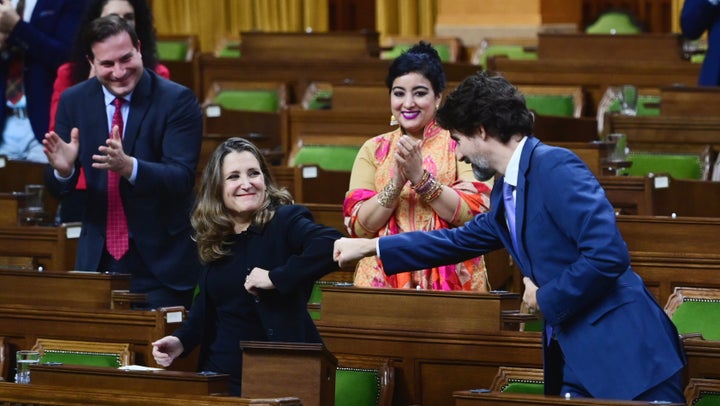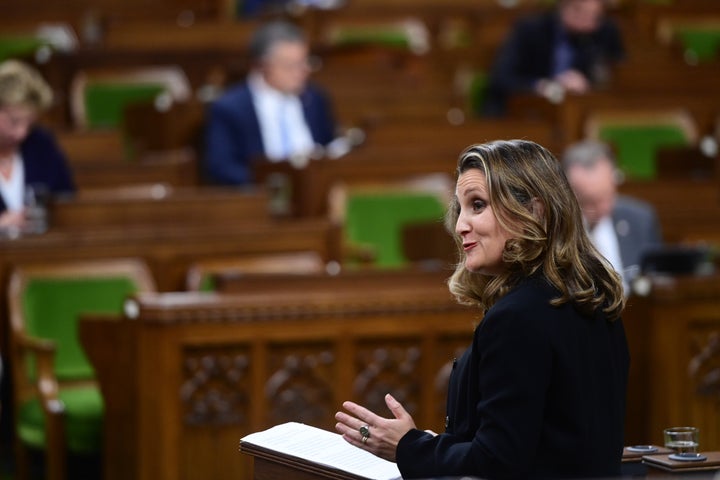
OTTAWA — Finance Minister Chrystia Freeland’s first economic update is a political document designed to win praise from key Liberal electoral constituencies and silence the Grits’ detractors by claiming fiscal discipline is coming and deeming austerity the wrong approach.
The opposition parties gave little indication Monday they will oppose the legislative measures included in the Liberals’ mini budget — a 237-page statement that identifies a $381-billion deficit, outlines an additional $271 billion in spending over the next five years, and promises another $70-$100 billion will be spent in unidentified stimulus to help restart the economy when the virus is under control and the threat of lockdowns has passed.
In the House of Commons, Conservative leader Erin O’Toole preferred to focus on what he called the Liberals’ “incompetence” in managing the COVID-19 pandemic and bungling the vaccine roll-out.
WATCH: Pandemic needs to be crushed before real economic recovery begins: Freeland. Story continues below.
“The minister of finance ... seems to realize she is putting the economy on hold,” he said. “She will say that we will rebuild the economy once COVID is beaten.
“Rapid tests could help preserve the economy, and the vaccine will help us beat it. The government is late and has no plan for both. Canadians should see that off the start.
“Canadians want their lives back,” he added.
Prepared for the Tories’ familiar line of attack, the Liberals’ fall economic update stresses that the government has spent $1 billion in vaccine agreements to secure the world’s most diverse portfolio of vaccine candidates. Ottawa has signed deals to have up to 429 million doses from seven different options. The federal government also notes that it has procured more than 38 million rapid tests, “which is three times the total number of tests performed in Canada since the pandemic began.”
“Canadians want their lives back.”
- Conservative Leader Erin O'Toole
But O’Toole stressed the Liberals have no roll-out plan. “A robust portfolio in 2023 does not help us as we enter 2021,” he countered.
(Health Canada officials said last week that the earliest they may approve vaccines is later in December with the first wave of vaccinations happening in January. The government has said it expects anyone who wants a vaccine to be able to get one by the fall.)
The NDP leader, Jagmeet Singh, and his finance critic, Peter Julian, suggested that what Canadians will see when they read the Liberals’ fall statement “is that austerity is coming.”
That charge was met with laughter in the House, with Freeland replying this wasn’t a criticism she’d expected.
Perhaps for good reason. The fall economic statement outlined billions in goodies, most for programs that will only begin next fiscal year — and probably only after the Liberal government survives another confidence vote.
Among the highlights:
- For the parents of young children: an extra $1,200 next year for every child under the age of six — $600 for families earning more than $120,000 a year.
- For women: a promise that the spring budget will finally include a plan to provide affordable, accessible high-quality child care across the country.
- For seniors: those worried about senior care, and those caring for seniors in long-term-care facilities, $1 billion over three years for a Safe Long-term Care Fund, for the provinces and territories to use to help prevent infection spread, by implementing new measures and controls, improving ventilation, hiring extra staff or topping up wages.

- For homeowners: the popular — but expensive — home energy retrofit program is back. This time $2.6 billion is proposed over 7 years to provide 700,000 grants of up to $5,000.
- For those hoping to enter the housing market in Toronto, Vancouver or Victoria — expensive locations and areas where the Liberals often find themselves in competitive two- or three-way races: the government proposes to expand eligibility for the First-Time Home Buyer Incentive, allowing for the purchases of homes worth of up to $722,000.
- For students: Ottawa will eliminate interest on Canada Student Loans and Canada Apprentice Loans for 2021-2022, and inject funds into the Canada Summer Jobs program and Youth Employment and Skills Strategy to create more job opportunities for young people.
- For Indigenous people: more than $2.6 billion to support health care, including support for mental health, as well as help to offset declines in Indigenous own-source revenue. More than $1.5 billion is also proposed to accelerate work on making drinking water safe in First Nations communities — a promise the Liberals made in 2015 election that should have been fulfilled this fall.
- For Black business owners: $93 million over four years to launch a Black Entrepreneurship Program to help ensure equitable eaccess to government procurement.
- For those worried about climate change: among several measures, the government plans to spend $3 billion to plant two billion trees.
- For businesses: the Canada Emergency Wage Subsidy returns to 75 per cent from the current 65 per cent from Dec. 20, 2020, to March 13, 2021. The Canada Emergency Rent Subsidy and Lockdown Support are extended until June, 2021. An expansion of the Canada Emergency Business Account (CEBA) was also announced, giving qualifying businesses additional interest-free loans of $20,000, $10,000 of which can be forgiven if the loan is paid back by Dec. 31, 2022.
- For those in hard-hit sectors such as tourism, hospitality, arts and culture, air travel and airports, more programs are on the way, including rent relief and a promise of a soon-to-be-announced “Highly Affected Sectors Credit Availability Program.”
- For businesses in battleground British Columbia — a province where the Liberals, the NDP, the Conservatives, and even the Greens in some parts, routinely duke it out: the government now proposes to create a new regional development agency for B.C. Regional agencies have been doling out assistance to many businesses unable to take advantage of other federal pandemic support programs.
- For dairy farmers — a politically active group — and other supply managed farmers: the government proposes spending more than $2 billion in compensation to offset trade impacts, and to help with productivity and marketing.
And the list goes on, and on.
For those worried that the Liberals are spending like drunken sailors, Freeland insists hers is a “prudent fiscal plan.” The crisis, she writes in the forward of the document, demands targeted, time-limited support to keep people and businesses afloat and to build the country’s way out of the COVID-19 recession.
“Our strategy is clear. We will do whatever it takes to help Canadians through this crisis.”
- Finance minister Chrystia Freeland
In the spirit of “transparency,” she says, the government wants Canadians to know it is prepared to spend 3 and 4 per cent of GDP over three years to help “Canada build back better.”
“...[T]he ultimate size and timing is highly dependent on the evolving health and economic situation. The government will establish more clarity around the size, timing and composition of the stimulus spending as virus risks abate, as we begin rolling out a vaccine and as we move toward Budget 2021,” the economic statement later states.
Tough decisions and accountability to come later, say the Grits. For now, they believe their plan is the first part of a larger effort to help stimulate an economic recovery.
WATCH: NDP say child-care plan must be backed with cash. Story continues below.
“Fiscal guardrails,” which are undefined but based on employment figures, will help establish when that stimulus will be wound down, Freeland says. And when the economy has recovered (in an undescribed manner), this time-limited stimulus will be withdrawn, the Liberals say, and Canada will resume a prudent responsible fiscal path based on an also unidentified long-term fiscal anchor. That anchor will be outlined only “when the economy is more stable,” the finance minister writes.
“Our strategy is clear,” Freeland adds, in her fall statement, “We will do whatever it takes to help Canadians through this crisis.”
As it happens, that may also mean: spend whatever it takes to ensure her government’s survival.